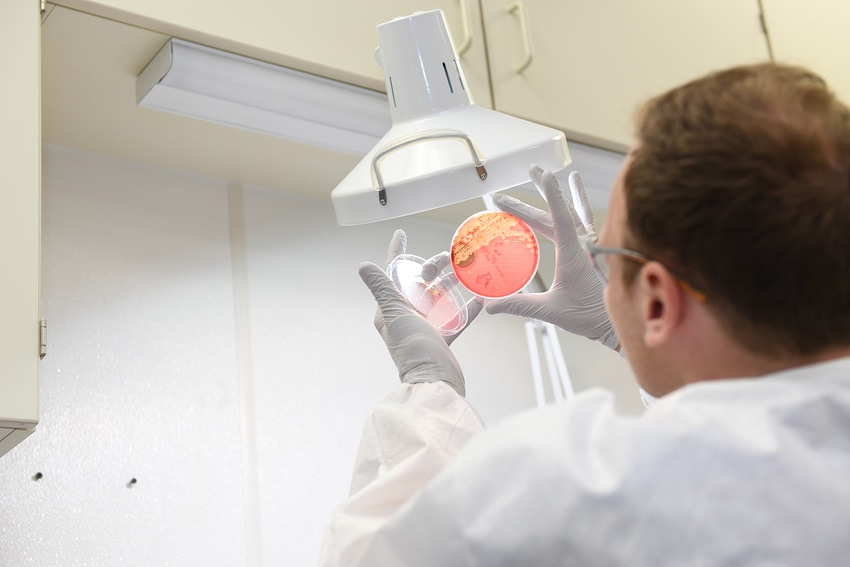Strep suis control: Ounce of prevention worth a pound of cure
Even with proper management protocols and a full vaccination program in place, Strep suis can still linger on farms.

As Streptococcus suis continues to rear its ugly head in nursery barns and wean-to-finish units across the country, one veterinarian says it may be due to the often overlooked need to ensure the right isolate is present in Strep suis vaccines, but could also be stemming from pig-care practices and unstable replacement gilts.
“It’s more than just identifying the right isolate, but making sure your vaccine has the right level of antigen in it, the right adjuvant and that the correct protocol is used when administering the vaccine,” says Keith Wilson, a senior professional service veterinarian with Newport Laboratories Inc.
From a vaccine standpoint, Wilson says having the right isolate and identifying its serotype is critical.
“If we get an isolate from an infected pig and it comes from tissue that is consistent with the clinical disease, we have a high level of confidence that that’s the bacteria causing the disease. So, that’s the isolate we would put into a vaccine,” Wilson says. “Most of our effort goes into identifying the serotype that is coming out of the diseased tissues.”
Identifying the different serotypes by selecting the isolates from diseased tissue is a focus for Newport Laboratories when developing custom-made vaccines for Strep suis.
“If we have a pretty high level of confidence that an isolate from diseased brain tissue is the one that’s causing the problem, we’ll sequence it, but we always like to confirm that with one or two additional submissions,” Wilson says. “If we get the same isolate from multiple submissions, that’s how we confirm it’s a significant bacterium to be using, and generally, we have pretty good success putting it into a custom-made vaccine and then seeing a response.”
Through their internal challenge model, Newport Laboratories has also been able to conduct research on the volume of antigens and adjuvants that go into their custom-made vaccines.
“With our internal models, we’ve been able to fine-tune that,” Wilson says. “Finding the right isolate, the right adjuvant and having the right amount of that adjuvant in the vaccine has been key.”
While Newport Laboratories recommends a full program of vaccinating sows pre-farrowing and individual pigs, Wilson says often there are other complicating factors involved.
“Having a good disease profile, knowing what else is going on at the same time, is pretty important. Working with the veterinarian to help sort out the primary and secondary causes of disease and making sure everybody’s doing everything they can to reduce potential causes of disease before they become problems is also key,” Wilson says.
Keeping Strep suis out also comes down to having well-trained staff.
“You can never take out the people component of raising pigs. It is so critical that there is good care of the pigs and the pigs are kept warm, dry and comfortable. The humidity levels within barns are really an important factor of reducing any disease,” Wilson says. “It really starts in the farrowing rooms, making sure those pigs get a good dose of colostrum from their moms. That is probably the most important thing that can be done to ensure pigs have the best chance of staying healthy.”
The other component Wilson says producers should consider is targeting replacement gilts on the farm.
“If there is currently a strep concern on the farm, when those new gilts come in, it’s important that they be immunized for the strain of strep that might be currently on a farm,” Wilson says. “It’s good to try to keep the farm stable.”
Even with proper management protocols and a full vaccination program in place, Strep suis can still linger on farms.
“If we are seeing a continuous strep problem after implementing a vaccine, and it’s the same strep strain in the vaccine, which we can identify through the whole-genome sequencing, then something’s not right,” Wilson says. “We would ask questions like, ‘Do we have unstable gilts coming in or is the vaccine actually not being given when it’s supposed to be given?’ Generally, it gives us the opportunity to look somewhere else to identify where the problem is.”
If they find another strep strain is present, a new vaccine with additional isolates can be created.
“It’s quite common for us to use two or three isolates in a vaccine because it’s common for there to be more than one strep strain present,” Wilson says. “Ongoing monitoring is absolutely critical for the success of the program.”
Finally, with the increasing pressure to reduce antibiotic use on the farm, taking a proactive approach could also save time and money down the road.
“This could free up some labor, reducing the number of pigs we have to treat,” Wilson says. “It’s always good to have prevention rather than treatment.”
About the Author(s)
You May Also Like





